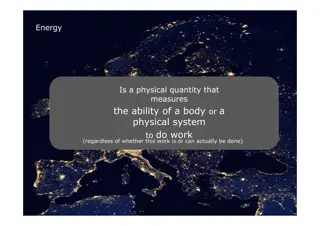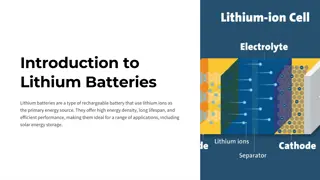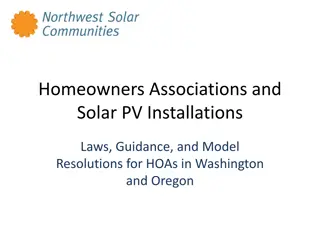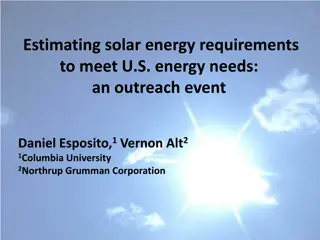Challenges and Costs of Community Solar
Concerns regarding community solar in Minnesota, including high costs, low reliability, and increased expenses for electricity consumers due to small panels and low electricity generation. Solar power's limitations and the need for fossil fuels are highlighted, along with the financial impact on consumers.
Download Presentation

Please find below an Image/Link to download the presentation.
The content on the website is provided AS IS for your information and personal use only. It may not be sold, licensed, or shared on other websites without obtaining consent from the author.If you encounter any issues during the download, it is possible that the publisher has removed the file from their server.
You are allowed to download the files provided on this website for personal or commercial use, subject to the condition that they are used lawfully. All files are the property of their respective owners.
The content on the website is provided AS IS for your information and personal use only. It may not be sold, licensed, or shared on other websites without obtaining consent from the author.
E N D
Presentation Transcript
Throwing Shade at Community Solar Isaac Orr Policy Fellow Center of the American Experiment February 14, 2019
Problems with Solar in Minnesota, Generally Solar Panels are expensive. Solar power is not abundant. Low capacity factors mean solar only shows up to work 18.2% of the time. Solar power is not reliable. These factors lead to high costs per kwh.
Problems with Community Solar Higher cost than utility scale solar because small panels = fewer economies of scale. Community Solar costs $135/MWH. Community Solar costs 4.3x more than existing coal generation. It costs nearly 2x more than utility-scale solar. Costs are passed on to other customers.
Cost of Solar Panels V. Other Generation Technologies
Abundant Solar? Hardly Solar produced just 18.2 percent of its potential, meaning most of the time, it doesn t show up to work.
Unreliable Energy Doesnt Reduce Our Need for Fossil Fuels We don t know how much solar output will vary day to day, week to week, month to month. Therefore, we still need fossil fuels to be available to produce energy when the sun isn t shining, and this is expensive. Your car isn t free because you rode your bike to work. Car payments, insurance, licensing fees, etc.
California Dreamin= Lots of Natural Gas and Importing 24 Percent of Their Power
Expensive Panels + Low Electricity Generation = Expensive Electricity Star Tribune article states the Community Solar initiative cost Xcel (and therefore electricity consumers) about $85 million per year last year, and these costs are expected to double to about $170 million in 2019. According to the utility, this increase in costs will result in customers paying an extra $39 dollars.
Community Solar is a Bad Value for Minnesota 505MW of capacity. At normal capacity factors, this means it would generate 805,000 MWH. Or roughly 1.3 percent of electricity generation. But Community Solar will make up 3.33 percent of household electric bills. This means it is a net loser for MN families.
Wont This Save Money? There will be avoided costs for coal and natural gas through the Community Solar program if the sun is shining, but these savings are vastly overstated. The fuel cost per kilowatt hour of electricity for coal is about two cents, but ratepayers must still pay the fixed costs for coal and gas plants, like capital costs and paying employees etc. Therefore, the entire argument that Community Solar can provide some windfall of cost savings for consumers is completely unsupported by the data. Spending 13.5 cents to save 2 cents makes no sense.
What About Lazard? Renewable advocate Lazard s Levelized Cost of Energy literature to suggest renewables are cost competitive, or lower cost than coal, natural gas or nuclear. However, these estimates are unrealistic.
Why Lazards Numbers Are Wrong Unrealistic capacity factors for solar and wind. 38 percent to 55 percent for wind. 21 to 32 percent for solar. Interestingly, no state has annualized capacity factors of 32 percent for solar. California has 28.9 percent. They do not account for transmission costs or providing electricity when the weather is not cooperating.
Levelized Cost of Energy for Minnesota Existing costs taken from FERC data. New LCOE costs use MN specific fuel costs and capacity factors and are unsubsidized.
Jobs? Renewable energy advocates often tout renewable energy as a major engine of job creation. However, these arguments fail to mention most of the jobs created by the wind and solar industry are temporary construction jobs that go away once the project is finished.
Solar Employment MN Solar and wind accounted for 4,016 and 2,088 jobs, respectively, in 2017. National Association of State Energy Officials, Energy Employment By State, Energy Futures Initiative, May 2018, https://bit.ly/2wzvWkX.
Jobs, Electric Power Sector MN 5,151 4,939 963 517 360 79 Utilities Construction Manufacturing Trade Professional Services Other Services
Jobs Because there were no natural gas, coal, or nuclear plants under construction in Minnesota and Minnesota Department of Commerce data show 467MW of solar was added in 2017, it is reasonable to assume most of these temporary jobs are attributable to solar and wind. Subtracting the total number of wind and solar jobs from the number of temporary construction jobs results in just 953 non-construction jobs in the wind and solar industry, meaning 82 percent of wind and solar jobs are temporary.
Why Repeal Community Solar? Repeal it. This is best for Minnesota ratepayers. Make it a separate line on utility bills so people know it s more expensive.























![Solarize [Municipality] Campaign - Empowering [Municipality] with Solar Energy](/thumb/250437/solarize-municipality-campaign-empowering-municipality-with-solar-energy.jpg)